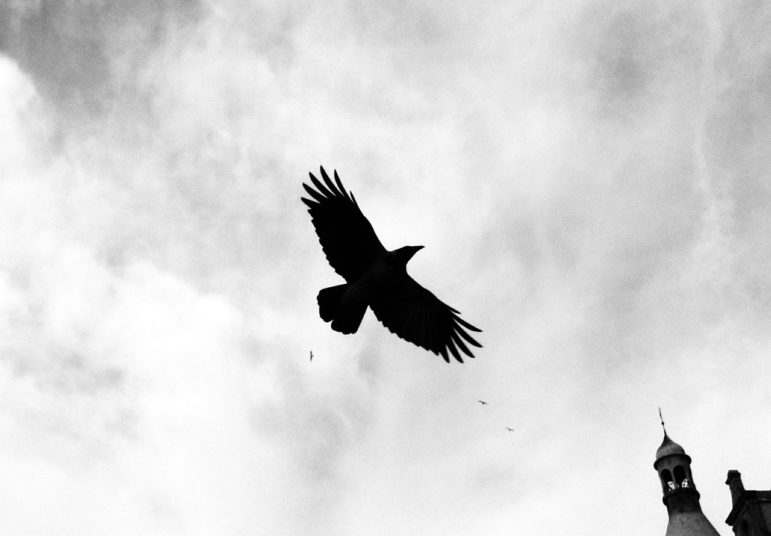
Sigur Rós’s Odin’s Raven Magic, released this Friday, may be the most exciting record of the year for a Heathen audience. The Icelandic band’s first album in seven years, Odin’s Raven Magic is a thoroughly engaging record even with no background knowledge, but Heathens will find much here that’s worth thinking over long the last track has played. The source material, the collaborators, and the musicianship all have plenty to offer for the interested Pagan listener.

A corvid flying against a gray sky [Pixabay]
Read some reactions to Odin’s Raven Magic and a few themes will become clear. “Odin’s Raven Magic isn’t a particularly easy listen, and it’s certainly not for your typical indie or pop fans,” writes Dave Beech at The Line of Best Fit. “Without a thorough knowledge of Icelandic mythology or the language itself, the album loses most of its impact,” says Mac Lockett at Grind. At NME, El Hunt argues that “Odin’s Raven Magic is built on incredibly specific foundations – the particulars of Norse Mythology and medieval Scandinavian poetry is certainly niche – so key aspects feel lost in translation without a hefty visual component or matching blur.”
I can’t speak for the typical pop fan, but Odin’s Raven Magic is hardly inscrutable. The album, which is the first official release of a live performance from early in Sigur Rós’s career, is not a pop album with distinct tracks, but rather a continuous symphonic score. If it weren’t for Sigur Rós’s success in the pop realm, Odin’s Raven Magic could comfortably be shelved with contemporary classical records. Approached from that perspective, it’s quite an inviting listen, an emotionally intense trip through mountains and valleys of electronic noise, choral harmonies, echoing percussion, and strings. The idea that the colors of this music will be muted if the listener isn’t fluent in Icelandic is, frankly, insulting, especially considering Sigur Rós’s famous use of the nonsense language Hopelandic in their 2002 record ( ).
That said, for Heathens and other Pagans, the album’s language is certainly worth examining. Odin’s Raven Magic adapts Hrafnagaldr Óðins, a post-medieval Icelandic poem that was often included in editions of the Poetic Edda until scholarly analysis suggested it was written in the 16th or 17th century. The poem describes a foreboding event in which Idunn, the goddess who guards the apples of youth, falls from the world tree Yggdrasil; this prompts Odin to send a number of gods, including Heimdall and Loki, on a mission to speak to a wise woman for news of the birth and death of the world. She does not answer them, except with tears. The gods return to a feast being held in Asgard and deliver the news. The poem ends with Heimdall about to blow the Gjallarhorn, perhaps signaling the beginning of Ragnarok.
In Odin’s Raven Magic, the poem is performed by Steindór Andersen, fisherman and foremost practitioner of the rímur style of poetic recitation; he has collaborated with Sigur Rós on several other projects, including an entire album of rímur in 2001. The rímur style has been one of Iceland’s most distinctive poetic forms for centuries, sometimes preserving the material of prose sagas that would otherwise have been lost. Steindór’s performance brings a gravity to the words that grounds the composition in the myth and history of Icelandic poetry, and provides a sonic counterweight to the falsetto vocals of Jónsi, the lead vocalist of Sigur Rós – this interweaving vocal pattern is best heard on the track Stendur æva, which both Steindór and Jónsi’s delivery meshes with the melodic percussion of the backing musicians.
Of particular note to Heathens is another collaborator on the record, the electronic musician Hilmar Örn Hilmarsson – likely better known to the Pagan world as the current allsherjargoði, or high priest, of the Icelandic Ásatrú organization Ásatrúarfélagið. Odin’s Raven Magic was performed in 2002, the year before Hilmar became the organization’s leader. His contribution is more subtle on Odin’s Raven Magic than Steindór’s, but the video of the performance shows him playing multiple instruments throughout, and his distinctive electronic tones give the record a satisfyingly experimental edge.
While I stress that the proper way to listen to Odin’s Raven Magic is by listening to the entire composition in one sitting – it really is a one-hour-long performance, not an album of individual tracks – the highlight of the record for me is “Dvergmál,” an instrumental track that heavily features the astounding stone marimba called a steinharpa assembled by Páll Guðmundsson. The interplay between the steinharpa, strings, drum kit, and chorus brings the listener through a vast space of emotional reflection, a symphonic interpretation of the grandeur and the despair that is to come throughout the rest of the narrative.
I gather that, while most Sigur Rós fans are delighted to have any new record, for some Odin’s Raven Magic is a bit of a letdown since it is not new music in the postrock vein that made the band a global success. But as a Heathen and a music-lover, I find that this album gets more interesting each time I listen to it. Odin’s Raven Magic blends Norse cosmology, Icelandic history and poetry, and expressive, haunting music by one of the world’s most prominent Pagan figures. This one should be a permanent part of any Heathen’s musical collection.
The Wild Hunt is not responsible for links to external content.
To join a conversation on this post:
Visit our The Wild Hunt subreddit! Point your favorite browser to https://www.reddit.com/r/The_Wild_Hunt_News/, then click “JOIN”. Make sure to click the bell, too, to be notified of new articles posted to our subreddit.
